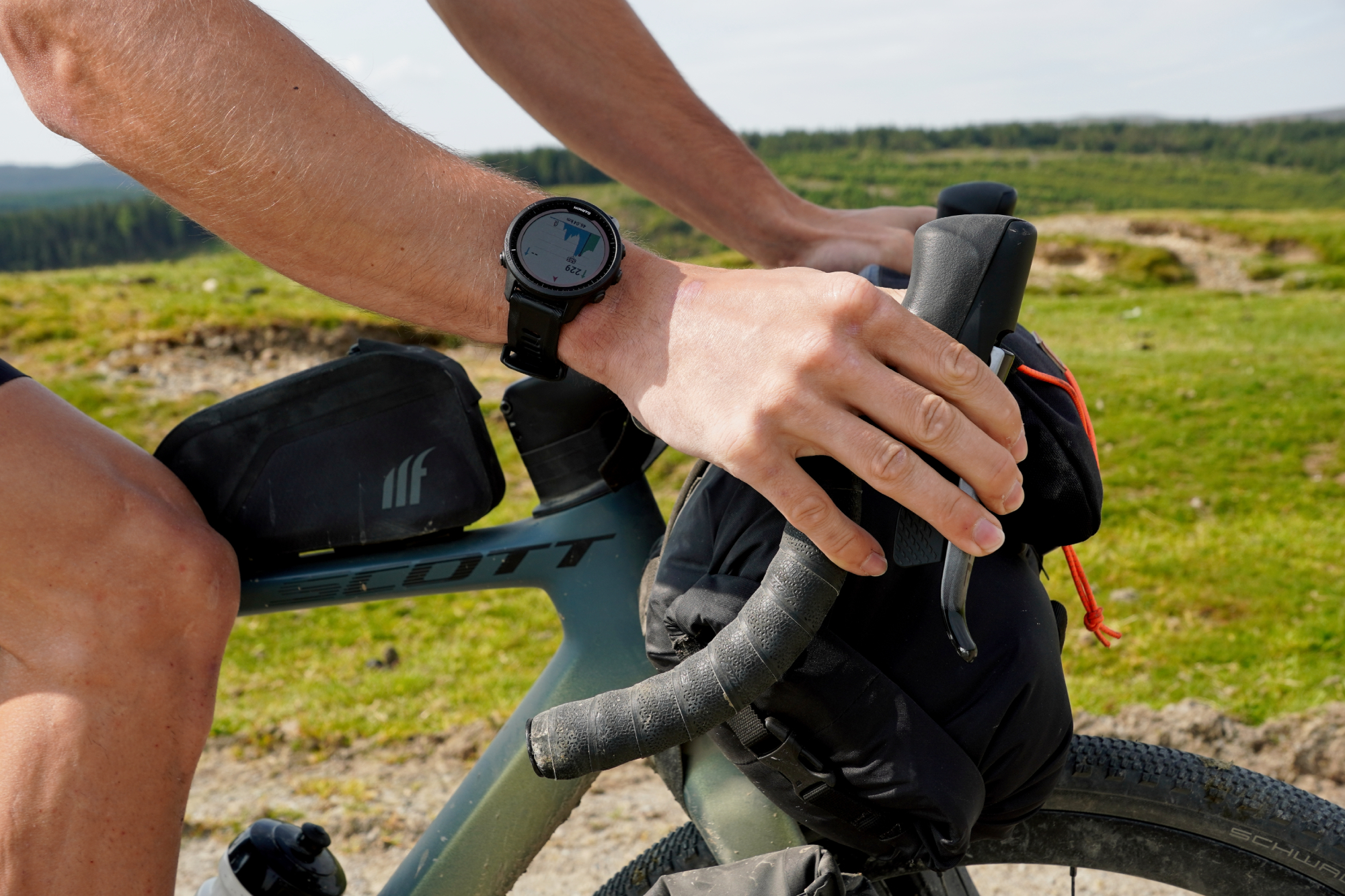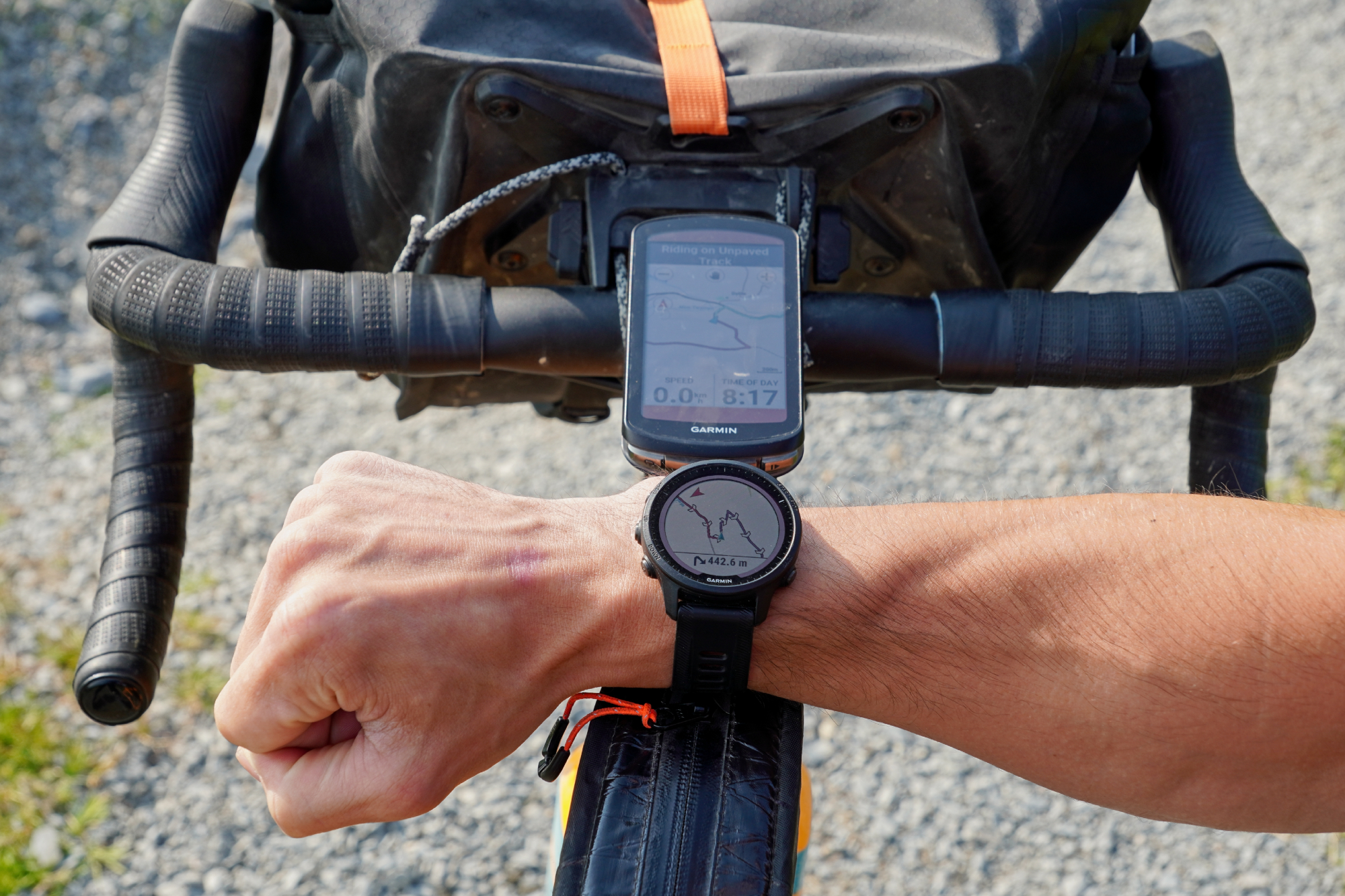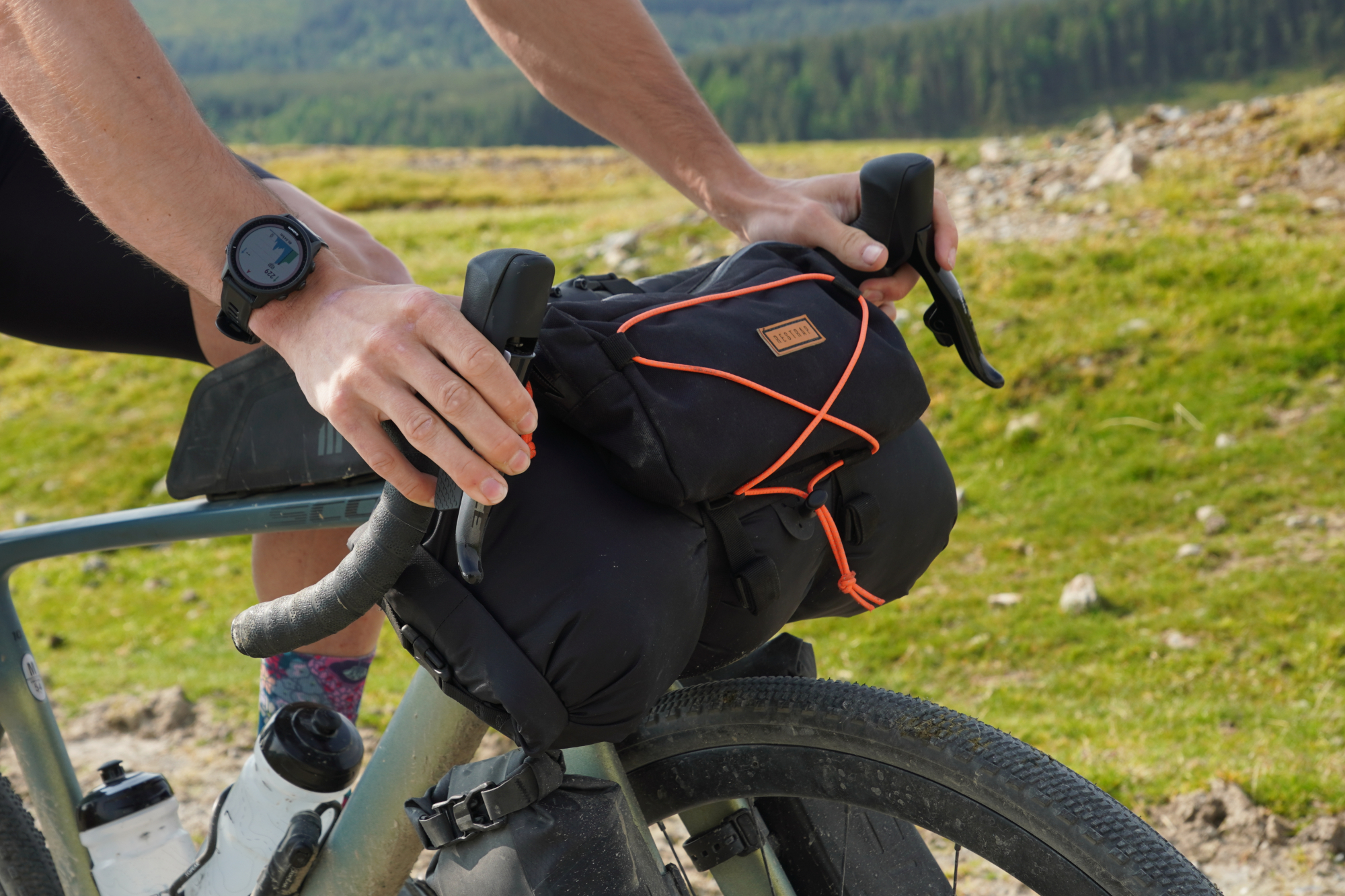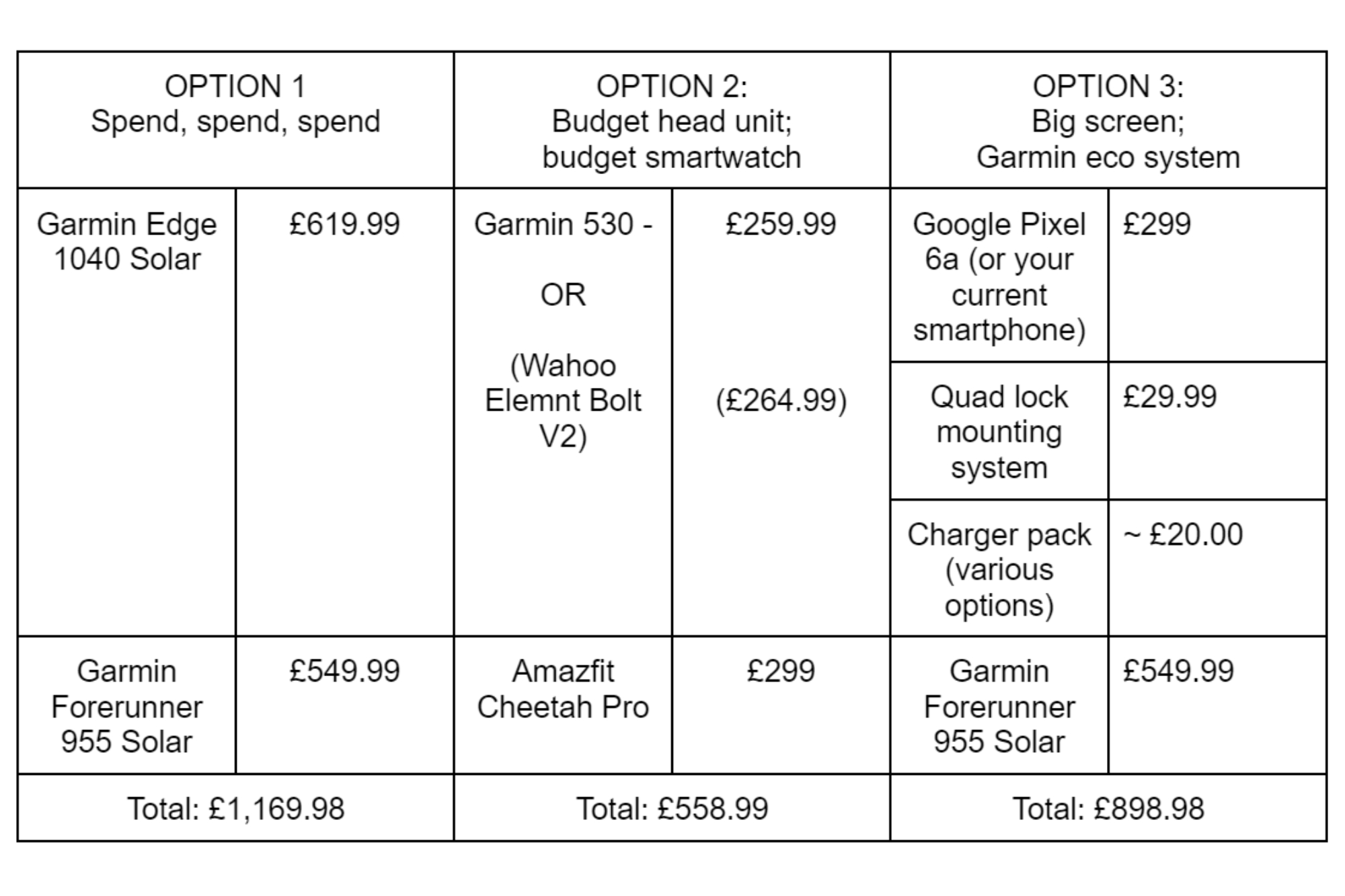Garmin Edge 1040 Solar vs Garmin Forerunner 955 Solar - can a smartwatch trump a bike computer for cyclists?
We put Garmin’s most expensive solar bike computer against its cheapest solar smartwatch - how do the two compare?


The latest smartwatches are impressive little devices. They offer a wealth of biometric insights, tracking your heart rate variability, sleep quality and incidental activity levels - amongst many others. With GPS navigation and topographic mapping, they’re handy for cross-training too, be that running, hiking, swimming or almost anything else.
But couple a smartwatch boasting all those features with its bike computer equivalent, and you’re looking at easily a grand’s worth of cycling tech - you could get yourself a whole other bike for that!
Of course, Wahoo, Garmin and all the rest would love it if we all carried on upgrading our head units every few years - and hooked ourselves into the same pattern with smartwatches. But could there be a better or, at least, a more economical way? Is it possible to dispense with the best cycling computers and simply use a smartwatch for all your health-tracking and on-the-bike navigation needs?
To get towards an answer, we put a Garmin Forerunner 955 Solar ($599.99 / £549.99) head-to-head against a Garmin Edge 1040 Solar ($749.99 / £629.99) on a three-day bikepacking ride across the Trans-Cambrian Way, cycling from the Welsh-English border at Knighton over to the river Dyfi’s estuary with the Irish Sea.

Garmin Edge 1040 Solar bike computer vs Garmin Forerunner 955 Solar smartwatch
Quick spoiler: there are no winners here, each device does have its pitfalls. But, on the other hand, this test has opened up a wider question (debate, Pandora’s box…) about the tech we choose to use as cyclists and the alternatives that there are. I’ll discuss that a bit further immediately below.
Cycling traditions
Despite cycling’s increasingly advanced applications of aerodynamic and material science, there are still plenty of aspects in which the sport really doesn’t bother trying to keep itself up to date. ‘Clipless’ pedals and the continued use of referring to tyres as ‘700c’ (a remnant of a long defunct French categorisation system which is now underpinned by the metric system) are perhaps the most prominent examples.
These could simply be a few choice curiosities now frozen in time. But there is an argument to be made that we’re in the process of ossifying yet another cycling idiosyncrasy: the idea that all ‘proper cyclists’ need a dedicated bike computer strapped to their bars.
The latest race content, interviews, features, reviews and expert buying guides, direct to your inbox!
Previously, a head unit made complete sense. Back in the ‘80s, ‘90s and most of the ‘00s, smartwatches and phones weren't an option - if you wanted to see your speed and other metrics on a ride you needed a dedicated computer on your bars.
Even around 2010, although it was by then possible to use a smartphone for navigation purposes, they were expensive items to perch on your handlebars and the battery life wasn’t great. Alongside this, wearable health trackers cropped up and then continued to develop, with the first FitBit hitting the market back in 2009.
It meant that circa 2013, the advice was quite straightforward: you should get a bike computer for tracking your ride and navigating, you can get a wearable fitness tracker if you really care about the granular level of your performance, and your phone should be kept in a waterproof bag in your jersey pocket.
Fast forward to 2023 and the lines are rather more blurred.
Fitness trackers morphed into smartwatches - and there are now plenty of models with full topographical mapping.

Smartphones have also crashed in price. For $349.00 / £299.00, you can get a Pixel 6a - which is 5G compatible and waterproof for 30 mins at a depth of one meter - for less than half the price of a Garmin Edge 1040 Solar bike computer. The Pixel 6a is actually cheaper even than the entry-level Edge 540 bike computer without the Solar tech, which retails at a punchy $349.99 / £349.99.
Of course, throwing money at the problem is always very much an option. You could simply continue buying new bike computers every few years as well as now a smartwatch for the health tracking and any cross training activities you do. Carry on keeping your smartphone safely tucked away in an ‘accessories pouch’ in your back pocket and upgrade that on its own, separate cycle.
Garmin and Wahoo would certainly rather that you did.
We have already done a smartphone vs bike computer head-to-head - and the smartphone option came out looking pretty good, at least for bikepacking. So now let’s look at the other side of the squeeze: how does the bike computer stack up against the smartwatch?
I’ll discuss the two and then delve into the myriad options and combinations regarding smartwatches, bike computers and phones further down the page.
Battery life
This is the area I was most curious about between the Garmin Edge 1040 Solar and the Garmin Forerunner 955 Solar, so let’s start here.
We began the first leg of the ride at around midday and ensured that both devices were fully topped up to 100% charge. Both were set to their ‘middle’ GPS location accuracy settings, and to keep things as controlled as possible, neither unit was connected to any external power meters or heart rate monitors.

By the end of the first day with each unit having been recording for about six hours, the Garmin Edge 1040 Solar had dropped to 93% and the Garmin Forerunner 955 Solar was down to 81%. A very impressive display by both devices, helped along by the very bright and sunny conditions with little cloud cover.
At the end of the ride, Anna turned off the Edge 1040 Solar and the battery life it had was fully carried over to the next day. With the Forerunner 955 being a smartwatch, I left it running in its usual standby mode (as you’d expect to) and lost a couple of percentage points through the night.
By the end of the second leg, each device had been recording for a total that day of about nine hours, with the scores on the doors 81% charge for the Edge 1040 and 33% for the Forerunner 955.
I was quite surprised to actually get a full two big days riding out of the 955 - particularly as I was using the watch’s mapping for the whole duration. The amount of charge I was left with was large enough that I didn’t even feel any degree of ‘range anxiety’ towards the end of the ride.
But the real star of the show was the Edge 1040 Solar - as it has repeatedly been in all our tests of its battery life. Finishing the second day at 81% meant that there wasn’t even a moment’s thought as to whether it needed a boost before the third and final leg - no need to faff about charging another device that evening.

Even so, I don’t think it is actually quite so obvious which device is the real winner here regarding the battery life.
Yes, the Edge 1040 Solar certainly lasts longer - but it’s also got a bigger battery that takes longer to charge. The Forerunner 955 is super fast to top-up and with its tiny size, I wouldn’t begrudge giving it some juice from the battery pack I typically reserve only for my phone. I’d be more reluctant about sharing that battery pack with a bike computer which draws more power.
There is more room for error with a bigger battery. If you accidentally leave the screen brightness on high (as I’ve done before) you can burn through that charge which normally lasts so long very, very quickly. If you were relying on the Edge 1040 Solar making it through the next few days without a top up, you could find yourself in a frustrating situation. Make a similar mistake on the watch and, although it’s annoying, it’s not a big issue because the battery simply isn’t very big.
On the other hand, there is a lot to be said for just not having to think so much and so often about charging devices. With the Edge 1040 Solar, it’s possible to go for days and days without having to plan your next top up. In the event that I did mistime a recharge, just a single boost from the battery pack would easily keep it going until the next time I reached a plug socket.
Navigation and data screens
Topographic maps have been a feature of the best smartwatches for cycling for quite a while now, but it still feels almost sci-fi having that information there on your wrist! Childish fun or otherwise, though, smartwatch navigation simply isn’t an ideal solution for cycling - and particularly not for gravel riding.

If you concentrate hard, you might just about be able to work out the trail directions from a look at your wrist, with your hands still holding the bars. For me, I find it much easier to simply raise my arm and hold the watch directly in front of me. That way the map is in the same orientation to the way I’m looking.
‘Easier’, though, is a relative term. It’s quite hard to focus on what is a fairly small map when your arm is shaking as you continue rolling over rough terrain. Depending on the trail, it’s even quite hard to keep the bike under control while you’re squinting and trying to judge which prong of an upcoming fork is the right one to go down.
With both hands on the bars and the map displayed on a computer which is fixed in position, it’s much easier balancing navigation and bike control. Although that’s not to say riding with a headunit is foolproof - there was the odd time when I made the right call about a turning after a glance at the watch, which Anna missed with the head unit. But more often it was the other way round.

It is true, though, that a smartwatch and a bike computer can be used across purposes. There are mounts out there for attaching smartwatches to your handlebars - although doing that means you sacrifice the health tracking data you’d otherwise be generating while riding, which is a big part of why many people might choose to invest in one. Plus there’s no getting away from the size of the screen on a smartwatch, which is a lot smaller than a head unit.
On the other hand, if you want to do a bit of cross-training - running or hiking, for instance - and you want proper mapping like you’re used to on the bike, there really is nothing stopping you using a bike computer such as the Edge 1040 for that purpose.
Holding a GPS unit in your hand can actually sometimes be easier than using a smartwatch with maps. The screen of a bike computer is bigger and it’s easier to flick through the data fields. On the flipside, always holding something in your hands is a frustration and it can be easy to accidentally touch the touchscreen - so using bike computers for other activities isn’t without its own flaws.
Data screens

The issues are similar with regard to the data fields. You can’t fit as many on the Forerunner 955 Solar as you can with the Garmin Edge 1040 Solar, plus it’s harder to read the data on them. Partially that’s down to the size, but it’s also because, like with the mapping, to clearly read a smartwatch you need to hold it in front of you, which is quite an involved process. With a bike computer, a quick glance down to see your stats couldn’t be much easier.

Just to stress, the actual mapping of the Forerunner 955 Solar smartwatch is good. When I’ve used it for runs and hikes I’ve really gotten on with it - and also for cycling, the way the trails are displayed is simple and clear. The issue is the inescapable mechanics of trying to look at a device that is strapped to your wrist while riding a bike.

One particularly neat feature of the watch is the elevation graph showing how much climbing and distance you have remaining. The Edge 1040 Solar is more functional in its display of that data, allowing you to pan and zoom - as well as simply being displayed on a larger screen. But sometimes minimalism is a virtue in itself, and I did quite like the elevation data that the Forerunner 955 Solar showed - and the fact that I couldn’t mess around with it.

So, to close out this section, if you’re thinking that a Garmin Forerunner 955 Solar might be a viable all-in-one solution - ticking off both your navigation and health tracking needs, as well as covering pretty much every sport you can think of - unfortunately, I have to break it to you that smartwatches aren’t the panacea they might appear.
Don’t get me wrong, you can get by using the Garmin Forerunner 955 Solar for your navigation on the bike - I did ride the whole Trans Cambrian Way doing just that. But it’s like making your toast in a frying pan: perfectly possible, but really you just want a toaster.
There are some edge cases, though. If you don’t care about seeing much of your data while riding along and live somewhere without many junctions, the 955 as an all-in-one solution will probably work very well for you. I’ve been on rides in the Highlands of Scotland where I’ve only had to be aware of approximately two junctions across the entire loop as there just aren’t that many roads. If that was where I lived, I might consider only using a smartwatch and ditching the bike computer.
But just because the Garmin Forerunner 955 isn’t an ideal solution for cycling doesn’t mean that you should go and drop $749.99 / £629.99 on the Garmin Edge 1040 Solar as your one and only device. To spend that much and not even have any health tracking to show for it feels like you’re not getting quite as much bang for your buck as you could.
It is also worth pointing out that smartphones have come crashing down in price in recent years - to the point that models with waterproofing and 5G connectivity are cheaper than even supposedly 'budget' bike computers.
Of course, if you’re the type of rider to choose an 800 series Garmin over the 1000 (or a Wahoo Elmnt Bolt over the Roam) expressly because of the smaller screen size and reduced bar clutter, then the fact that a smartphone makes for a more economical navigation system than a bike computer needn’t factor into your decision calculus.
But if a large screen is one of your primary concerns and you’re wondering how to best balance the competing pull of health tracking and navigation - then maybe it’s worth taking a step back for a moment and considering all of your options.
In the next section, I take a look at the various alternatives out there, and what combination best meets which price point and who it would suit.
Should I get a smartwatch and a head unit?

Option one is just to provide the context for what investing in a high-end bike computer and smartwatch could potentially come to. This isn’t a ceiling - there are many smartwatches more expensive than that of the Forerunner 955 Solar, which is actually quite competitively priced for its functionality.
Option two is a suggestion for anyone who wants a small bike computer on their bars, as well as a smartwatch for the health tracking and the mapping functionality when cross training - but who absolutely doesn’t want to break the bank. If you wait for a good discount, it gets even cheaper.
Finally, option three is for someone who wants to stay within the Garmin ecosystem, but who would also like a larger screen to navigate with and the full functionality of a smartphone. All together, the price is still substantial. But the bulk of that is a consequence of the Garmin Forerunner 955 Solar smartwatch. Plus, if your current phone can do the job - or if you were planning on upgrading anyway - you can subtract that from the total, too.
Some cycling tech has dropped significantly in price of the years. Power meters and effective bike lights are two prime examples. Bike computers, though, seem to be going the same way as bikes in general - ever more tech and ever more expensive. It makes you wonder how long this can continue.

After winning the 2019 National Single-Speed Cross-Country Mountain Biking Championships and claiming the plushie unicorn (true story), Stefan swapped the flat-bars for drop-bars and has never looked back.
Since then, he’s earnt his 2ⁿᵈ cat racing licence in his first season racing as a third, completed the South Downs Double in under 20 hours and Everested in under 12.
But his favourite rides are multiday bikepacking trips, with all the huge amount of cycling tech and long days spent exploring new roads and trails - as well as histories and cultures. Most recently, he’s spent two weeks riding from Budapest into the mountains of Slovakia.
Height: 177cm
Weight: 67–69kg